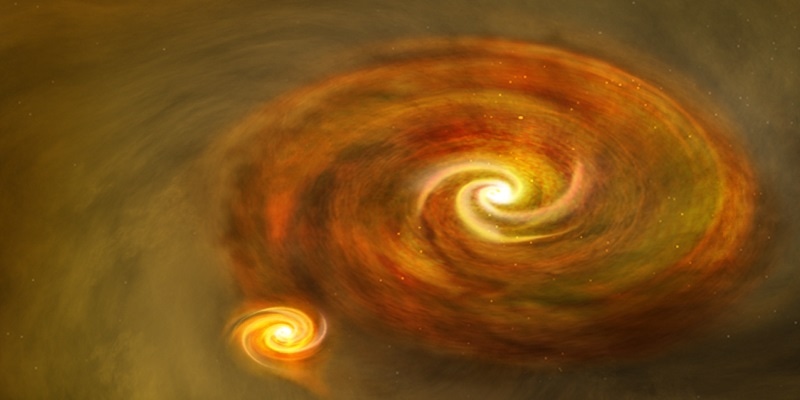Mar 12 2019
A binary star system having high-mass young stellar objects located closest than ever measured has been discovered by astronomers, offering a valuable “laboratory” for the investigation of theories related to the formation of high mass binary stars.
 Artist’s impression of how binary stars form. (Image credit: B. Saxton, NRAO/AUI/NSF)
Artist’s impression of how binary stars form. (Image credit: B. Saxton, NRAO/AUI/NSF)
A team of international researchers headed by the University of Leeds has ascertained that the distance between the massive young star PDS 27 and its orbiting stellar companion is only 30 astronomical units, or 4.5 billion kilometers.
That is approximately equal to the distance between the Sun and Neptune, which makes them the stellar companions with the closest proximity than calculated ever before for young high mass stars in a binary system—a star system including two stars orbiting around a center of mass.
An Exciting Discovery
This is a very exciting discovery, observing and simulating massive binaries at the early stages of their formation is one of the main struggles of modern astronomy. With PDS 27 and its companion we have now found the closest, most massive young stellar objects in binaries resolved to date. There is a shortage of known young massive binary systems in charted space. High mass stars have comparatively short lifespans, burning out and exploding as supernovae in only a few million years, making them difficult to spot. This limits our ability to test the theories on how these stars form.
Dr Evgenia Koumpia, Study Lead Author, School of Physics and Astronomy, University of Leeds.
Close Stellar Companions
In their study, the researchers also found out a companion object for PDS 37, another young massive star. The study showed that the distance between PDS 37 and its companion was about 42 to 54 astronomical units—somewhat equal to the distance between the Sun and Pluto.
Although PDS 37 and its companion are located further away compared to PDS 27 and its companion, it is still an important finding with the emergent need for confirming massive young stellar binaries in astronomical studies.
How these binary systems form is quite a controversial question with several theories having been put forward. Observational studies of binaries in their early stages are crucial to verifying the theories of their formation. PDS 27 and PDS 37 are rare and important laboratories that can help inform and test the theories on the formation of high mass binaries.
Dr Evgenia Koumpia, Study Lead Author, School of Physics and Astronomy, University of Leeds.
According to Dr Koumpia, compared to the Sun, PDS 27 is at least 10 times more massive, and around 8000 light years away. The existence of stellar companions for PDS 27 and PDS 37 was determined by the researchers with the help of the extreme spatial resolution offered by the PIONIER instrument on the European Southern Observatory’s Very Large Telescope Interferometer (VLTI).
Combining light beams from four telescopes, measuring 8.2 m across, the instrument simulates a single telescope that has a diameter of 130 m. The ensuing high spatial resolution power enabled the researchers to resolve such close binary systems in spite of their enormous distance from Earth as well as their close proximity to one another.
The next big question—which we have tended to avoid so far because of observational difficulties – is why so many of these massive stars are in binary systems? It has become increasingly clear to astronomers that massive stars are almost never born alone, with at least one sibling for company. But the reasons why that is the case are still rather murky. Massive stars exert significant influence on their cosmic environment. Their stellar winds, energy and the supernova explosions they generate in turn can impact the formation of other stars and galaxies. The evolution and fate of high-mass stars is quite complex but previous studies have shown that they can be influenced to a large degree by their binary properties. The discovery of massive young binary stars provides a crucial step forward in being able to answer many of the questions we still have about these stellar objects. These discoveries were only possible thanks to the exquisite resolving power provided by the PIONIER instrument on the VLTI.
Rene Oudmaijer, Study Co-Author, Professor, School of Physics and Astronomy, University of Leeds.
This study has been published in the Astronomy & Astrophysics: Letters journal.